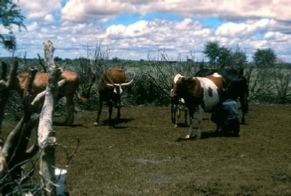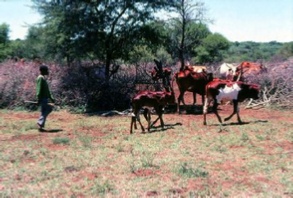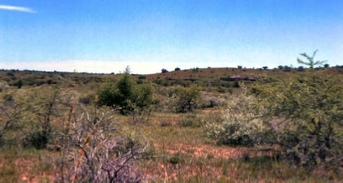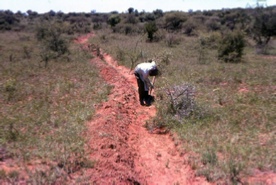Growing crops is traditionally the responsibility of the women, the Cattle-post and livestock on the other hand is the traditional domain of the men. Ownership of cattle is traditionally very important as not only do cattle represent the family wealth and draught power but they are used on a variety of family occasions and cement a network of social relationships. Their important role in Bogadi (bridewealth) and marriage is illustrated in the sections on Marriage, their milk is of obvious importance both as fresh milk (mashi a lobese) and the very much liked sour milk (mashi a madila). Slaughtering a cow involves a number of customary gifts of meat to cement relationships with kin and also please Badimo (Ancestors).
Certain parts of the bones are important to Dingaka (Traditional Doctors) for their ditaola (divination bones) - see Traditional Medicine. Cattle skins are used for sleeping mats and at death (those from specially slaughtered animals at a funeral were traditionally wrapped around the body for burial. Bulls traditionally were presented to the owner's Malome (maternal Uncle) and also used in Tatolo - to "tell" a man's death, before his property was divided (see Death). Disputes over cattle frequently lead to kgotla cases and sorcery Even today a person with any spare money, for example, money earned in the mines, will still invest it in the purchase of cattle.
Cattle are kept at the family Cattle-posts, which are located outside the village but are entirely separate from the Lands. In 1928 Bathoen 11 enforced this separation by a decree stating: "fields in grazing areas must be moved away and Cattle-posts in arable areas must be moved away". (This repeated earlier decrees made by Chiefs Seepapitso 111 and Bathoen 1)
Traditionally Cattle-posts of paternal kin from the same kgotla are located in the same area. The men of the family supervise the young boys who herd and water the cattle by day and kraal them by night in the family kraal just outside the homesteads. The herd boys milk the cattle when they are in milk, and look after the goats, which are kraaled in a separate kraal adjoining the cattle kraal.
Because of the water problem, particularly during the dry season, groups of cattle owners (or even individual richer farmers) will construct a dam that is used during the dry season. These are constructed in river courses and usually enclosed with a thorn bush fence. Other people may use bore holes, these vary from the well-type, where the water is wound up bucket by bucket, to the modern diesel-pump bore holes. Experiments are being conducted using windmill pumps, and bio-gas (from cattle dung) pumps.





Traditional cattle kraals where cows are kraalled at night to protect them from wild animal attacks



Typical traditional cattle post. Cattle are grazed in surrounding land during the day and kraal for protection at night. Herders sleep in homestead



Cattle post out in the Kalahari. The owner (a successful businessman) has bought pedigree cattle to improve his herd



Owner on a visit to inspect his herd. The cattle are cared for by herdsmen. The kraal is of substantial construction
A borehole has been drilled and water is pumped into these tanks to water the cattle
The day at the Cattle-post starts early. The herd boys let the livestock out of their kraals (calves and kids may be left behind in special kraals) whilst the main herds are taken out to be watered and grazed. The herd boys spend the days not only herding the cattle but also hunting small animals with their catapaults, at which they are renowned for their prowess. Towards sunset the cattle.are returned to the kraal, and milked. Some milk will be drunk fresh and the rest made into sour milk that can be sent to the relatives in the village or at the Lands. Excess milk and sour milk is often sold, particularly by those who are lucky enough to have Cattle-posts near to the village. This can be a lucrative supplementary income, for example, in 1980 fresh milk sold at 25t a bottle.
Cattle-posts are of course "put" by the kgotla traditional doctor and protected by the family lenaka (medicine horn). Women may stay at the Cattle-posts, for example this is a favoured location for a woman to do her Botsetsi (seclusion following confinement) because of the availability of milk, sickly children are often sent to live at the Cattle-posts so that they may drink milk. But there are certain traditional beliefs and practices that are followed regarding women and cattle. Although the women from a family are usually allowed to enter their kraal, there is often a taboo against women who are not family members entering a kraal, also women do not enter the kraal when they have maoto a molelo "hot blood" (menstruating, pregnant, widowed etc.)
A widowed person is always brought out to their Cattle-post as part of the curing rituals (see section on Death). If cattle have accidents or miscarriages or the bull does not make the cows pregnant the traditional doctor will be called to see what is wrong with them (see “Washing the Bull” in section on Traditional Medicine). A family's cattle is frequently the target for sorcery (see section on Sorcery).
Cattle are often used as payment to a traditional doctor for different cases or a certain colour and type of cow may be demanded as part of a cure.
Besides cattle, goats and sheep are kept at the Cattle-posts. Whilst these are not so socially important as cattle, sacrifices, payments etc., may be made with these, for example, a sheep is given to and slaughtered for a mother when she becomes a Motsetsi by the baby's paternal kin; a sheep is also slaughtered during the curing of a widowed person by the husband's family etc.
It is still true to say that possession of a large number of cattle is greatly respected and has not been superceded by large sums in bank deposit accounts.
Cattle breeding is one of the main economic pursuits, cattle products forming an important export. This has not always been the case as there were traditionally laws against selling cattle, particularly against selling breeding stock. These tribal laws had become necessary because by 1890 livestock and hides had replaced ivory and hunting spoils as commodities most bought by European traders. The law controlling the selling of the breeding stock was introduced by Bathoen 11 in 1939. In 1911 a law had been introduced to try to control stock theft - this law forbade the selling of livestock in the veld, all such sales had to take place in Kanye.
Moraka - The Cattle-post













